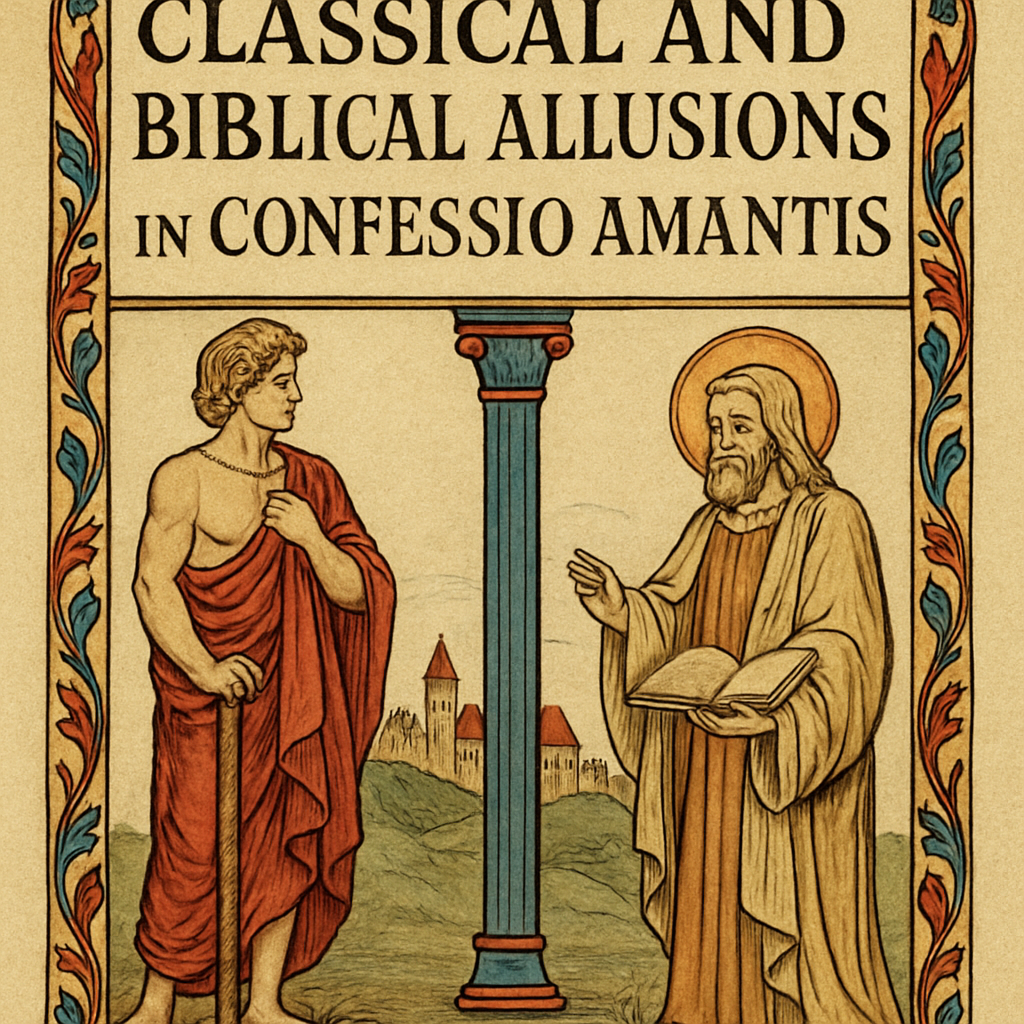Introduction
Classical and biblical allusions in Confessio Amantis by John Gower enrich its moral purpose. Gower weaves stories from ancient Rome and scripture into his poetic narrative. These references support his vision of ethical instruction and human understanding. By drawing on myth and religion, he builds a connection between classical wisdom and Christian doctrine.
Gower’s Literary Strategy
John Gower uses these allusions as narrative devices. They help illustrate moral lessons told by Genius, the priest of Venus. Each tale, drawn from famous sources, aligns with themes of love, virtue, and sin. As a result, readers find familiar stories with fresh moral interpretation. This blend enhances both accessibility and depth.
Biblical Themes in the Text
The biblical allusions often focus on spiritual consequences. Stories of Cain, Noah, and David warn about disobedience, pride, and temptation. These allusions are not decorative. Rather, they serve a didactic function. They teach the consequences of vice through religious context, making them central to the poem’s message.
Classical Myths as Moral Lessons
Gower adapts classical mythology to convey ethical meanings. For example, he retells the story of Narcissus to explore the danger of self-love. The tale of Pygmalion is used to examine idealized love. These classical and biblical allusions are carefully placed. Their purpose is moral clarity rather than mere storytelling.
Transition Between Cultures
The poem connects classical paganism with Christian ideals. It shows how both traditions offer valuable moral insights. Gower does not dismiss pagan stories. Instead, he reshapes them through a Christian lens. This thoughtful use of classical and biblical allusions highlights the shared values in different traditions.
Educating the Audience
Gower wrote Confessio Amantis in English, unlike many of his Latin contemporaries. This choice aimed to reach a broader audience. Through classical and biblical allusions, he educates readers without alienating them. These references bridge the gap between learned and common audiences. They foster a shared cultural understanding.
Symbolic Power of Allusions
Allusions carry emotional and symbolic weight. When Genius speaks of Lucifer’s fall, the reader recalls spiritual rebellion. When he references Ulysses, ideas of cleverness and deceit emerge. These classical and biblical allusions deepen the emotional impact. They turn moral instruction into an engaging experience.
Structured by Sin and Story
The poem is structured around the seven deadly sins. Each sin is illustrated with tales, many of which use these allusions. For instance, wrath is explained through stories like that of Cain. Pride is illuminated by the tale of Nebuchadnezzar. These structured examples provide clarity and repetition.
Gower’s Unique Voice
Although Gower draws heavily on older texts, his voice remains unique. He uses classical and biblical allusions not to mimic but to comment. He offers moral conclusions tailored to his time and audience. His adaptation of ancient material becomes a reflection on medieval society.
Allusions in the Prologue
The prologue of Confessio Amantis sets the stage for learning through history. Gower speaks of emperors and prophets alike. His references to both classical rulers and biblical prophets show balance. These early classical and biblical allusions establish the poem’s scope. They also reveal his intention to unite different sources of wisdom.
Gender and Morality
Some allusions also address gender roles. Biblical figures like Eve and Delilah are mentioned. Classical characters like Medea appear as warnings. These classical and biblical allusions explore moral expectations for women and men alike. They reveal medieval views of power, loyalty, and virtue.
Political Commentary through Allusion
Gower sometimes uses allusions to make political points. He compares rulers to biblical kings and Roman emperors. These classical and biblical allusions suggest how leadership should align with justice. By referring to well-known figures, he critiques and advises contemporary leaders indirectly.
Allusions as Authority
Gower’s use of allusions also boosts his authority. By referencing scripture and classical texts, he presents himself as knowledgeable. These classical and biblical allusions lend legitimacy to his moral arguments. Readers are more likely to accept guidance that echoes sacred and historic sources.
Morality Across Time
The combination of ancient and biblical stories allows Gower to argue for universal morality. His point is clear: truths about love, sin, and virtue do not change. Through classical and biblical allusions, Gower links past and present. His medieval audience hears timeless lessons told anew.
Interpretative Flexibility
Gower’s tales leave room for reflection. Allusions are not always explained directly. Readers are encouraged to think critically. These allusions offer layered meanings, depending on one’s perspective. Thus, Gower invites participation in the moral dialogue.
Allusions and Intertextuality
The poem is rich with intertextual moments. When Gower references Ovid or the Bible, he engages with those texts. These classical and biblical allusions become part of a broader literary conversation. The poem gains depth through its relation to earlier works.
Avoiding Overuse
Though Gower uses many allusions, he avoids excess. Each serves a specific purpose. He chooses classical and biblical allusions that reinforce the narrative. Their presence is intentional and controlled. This precision keeps the reader focused on meaning rather than spectacle.
The Role of Genius
Genius, the narrator, often explains the stories he tells. His commentary helps guide interpretation. Through him, classical and biblical allusions are made accessible. He ensures the audience understands the moral link between story and sin.
Allusions Across Sin Categories
Each of the seven deadly sins contains tales with strong references. Lust draws from both classical and biblical examples. Gluttony uses feasting tales from scripture and myth. These classical and biblical allusions provide contrast and coherence. They show how sin appears in every culture.
Reflection on Human Nature
Ultimately, Gower uses allusions to reflect on humanity. People of all ages face the same moral challenges. These classical and biblical allusions show how stories transcend time. They allow Gower to explore deep truths in a relatable way.

The Seven Deadly Sins in Confessio Amantis: https://englishlitnotes.com/2025/06/12/the-seven-deadly-sins-in-confessio-amantis/
The Theme of Piers the Plowman: https://englishlitnotes.com/2025/06/11/the-theme-of-piers-the-plowman/
If by Rudyard Kipling: https://englishwithnaeemullahbutt.com/2025/06/02/poem-if-by-rudyard-kipling/
Who vs Whom: https://grammarpuzzlesolved.englishlitnotes.com/who-vs-whom/
Discover more from Naeem Ullah Butt - Mr.Blogger
Subscribe to get the latest posts sent to your email.
